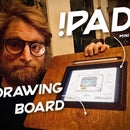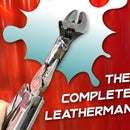Introduction: Handheld Projector X 4
This is my favorite project the past year, learning Fusion 360 has been incredible!
From a very basic start, I made 4 iterations of a handheld projector! It's time to share the process, result, and future goals.
With 4 different designs there is a lot going on, I've split it up in 4 parts, but as you'll see some ideas are overlapping and feeding on each other.
This project is still ongoing so if you have input please let me know!
Supplies
Micro:bit (https://microbit.org)
Step motor 28BYJ-48-Module (Amazon.co.uk)
USB cable
5V battery pack
Silicone grease (lubricating 3D printed threads)
Convex Lens Glass (Aliexpress.com)
- - - - - - - - - - - - - - -
Tools:
For any 3D project there is one tool that rules them all… CALIPERS!!!
I've fallen in love with Fusion 360, it's only been a year and 3 months getting to know this software, can't wait to see what I'll be making in another year:-)
After a month of using an Ultimaker2, I settled on a Prusa MK3 printer, 100% happy
Step 1: Revenge of the Analogue!
One of my collections here on Instructables is labeled "Projection". I've been fascinated by this technology for a long time, slide projectors, film projectors, and now digital projectors. In my research I've come across projects where fellow makers have embarked on their own projection adventures. Some completed, while others are put on hold for various reasons. I've taken inspiration from these and some of their ideas can be seen in my own process. This is how it works we build on others before us.
I've included some of the research/inspiration here:
https://www.kickstarter.com/projects/weareprojecto...
Step 2: 3D Printing, Yesssss!
For anyone still wondering if 3D printing is something they should dip their toe into, I can only say this… Hell yes!
I had my 3D printing awakening about a year ago. For a month I borrowed a printer from work and could not stop. After delivering this marvel back I bought my own, a Prusa MK3, which I built myself (ok, with some much needed help:-) I'm not going to talk you into getting started with 3D printing, by sharing this Instructable I hope you'll see how great fun it can be!
First, to have full advantage of the opportunities with 3D printing you need to learn a cad software, I had tried 123Design a while back and liked it for its simplicity, but due to it being discontinued I decided to put my fear away and dive into Fusion 360.
The best start you can have is following Lars Christensen and his:
This 3 episode introduction will give you a jumpstart in use and understanding of F360 basic principles. 1 hour invested will payback in 1000 happy hours of modeling:-D
As a final note on the splendidness of F360, one word… threads! (more on that later)
Step 3: But Where to Begin…
It's obvious… start simple! My first test was to make a ring that would fit the drill opening. Which is basically a cylinder with different widths. Next, I started designing the slide housing, this again is a… box, with a square space for the slide and a hole for the light to pass through. I then made a new part/component for the lens I had, again, a cylinder with a rectangle shape to attach to the slide housing.
You got to think "add and subtract"
At this point in the process, I hadn't seen the possibilities with threads so when these 3 parts were printed I epoxy glued them together.
I made this design in 3 parts, why? Well for starters it is so much easier when you break down your design to smaller components. Second, when printing you want as little support material as possible to make your print smother and less clean up.
Look at how I placed them on the print plate, placing the slide house at 45 degrees generates very little support!
Step 4: Pen to Paper!
These are the first sketches based on the drill design. I always sketch before I make something (eh… ok sometimes I'm too eager, but that usually backfires:-)
With 3D design I know now that it is pointless to even open up the software if I don't have a first sketch and some measurements.
Calipers to the rescue!
Step 5: Part 1: the Drill Viewer
Like so many other projects this started off with stuff I had laying around my workshop, a broken drill. While pulling it apart for harvesting motors and other gems I realized how much space was inside when pulling everything out. Also, I noticed a lip on the inside where the motor had been attached, what if I could attach a new part to this handheld device? Could I make it into a handheld projector?
Oh yesss I could, but could I really. I would need to cad something I'd never made before.
I pulled out the calipers and measured the inner dimensions and made a quick object in F360, had it printed to see if it fit. It did, with some adjustments needed. Now it was pretty simple to imagine the rest. I knew I wanted to make a housing for a single slide.
A 10 watt LED was attached to a heatsink, and a 12 volts battery connected externally.
To adjust the lens for perfect focus I made a threaded hole for an adjustment bolt.
Step 6: Part 2: a Fully 3D Printed Viewer
This was the obvious next step, I wanted to have full control of the design of the body. The LED (10 watts) was not as strong as I wished for and I had flashlights that produced less heat and were much stronger. So the first version was made based on the drill design. The slide house got some adjustments and the flashlight holder was cone-shaped to fit the super-strong flashlight.
Printing all the components took a full 24 hours. As you can see the print delivered, but now I tend to break things down and not print everything at once.
This was also the starting point for coming up with refinements so others could download and build their own.
The camera pistol grip was made by blu006
https://www.thingiverse.com/thing:1966894
Step 7: Lenses…
At this stage I used old slide projector lenses I've been collecting for a while. I have different brands and sizes. The quality was great, but they are quite heavy and hard to come by for others. So I started designing a version I could 3D print and add a lens bought separately online.
I've ended up with a Convex Lens Glass from Aliexpress.com.
In the green photo, you can see the 3D printed lens, with the lens glass on the left.
Step 8: Testing in London… Next Makers Central
Not sure what I was thinking when I brought this to London, but I was on my way to the second Makers Central 2019 in Birmingham and thought I'd do some promo for this fantastic event! Luckily no passerby reported me to the police!
To make the most out of it, I made slides with logos of my favorite makers I knew would come to MC2019. That way I got their attention:-)
Step 9: Slides, Film and Wheel
I've been printing slides for a long time now on my inkjet printer, an Epson XP 950. Transparency film comes in many qualities, so far both cheap and expensive have delivered. The biggest challenge is to have your printer do the print in full rich black, if not the black won't be opaque and light will leak.
Cutting for the traditional 35mm is straight forward, both single slides and film strips you only need a metal ruler. For the circular reel, you can either, like me, use a circle cutter or go freestyle with a pointy utility knife.
I've included a pdf template…
Attachments
Step 10: How Many Parts?
With the threads option built into F360 it is very easy to make parts connect to one another. What I've learned first hand so far with 3D printing is that you'll have fewer issues if you break your designs into smaller parts and then attach them when for the final assembly.
So it became evident that I needed to make full use of threads locking the different parts together. This also made it easy to add options for flashlights having various diameters to their fronts.
As this project progresses you'll see what I mean:-)
Step 11: Part 3: Motorized Viewer
The Motorized Viewer came about when looking into projecting more imagery without the delay of switching the slide. I only just recently dived into programming but only enough to realize I could maybe use a Micro:Bit controller and a stepper motor.
This setup would allow me to advance a roll of "film" at a programmed rotation value. If I press button A, the stepper motor would turn one full round.
This meant I had to design a holder for the Micro:Bit and the stepper motor + board… and a way to contain the strip of film before it was fed into the slide house and onto a spool (rotated by the stepper motor)
I found a cheap and strong enough motor, but before I made everything ready to print I needed to find the right code. Not being a coder I googled my way to this page:
Here I found code specific for the Micro:Bit, I hooked up all the wiring and tested the code to see if it would turn the motor at my desired rotation value. Oh yessss, it worked and best of all, the Micro:Bit programming language is easy to understand, It's called block programming. You pull blocks of code in and stack it in the right order. To your convenience you see the code run on a virtual Micro:Bit in the software, so you can see if it works before loading it onto the board.
Step 12: Threads, You Gotta Love'em!
As I said earlier, threads are fantastic! In Fusion 360 there is a built-in threads creator (Create menu, middle), this makes any hole or outer cylinder a thread in seconds.
I went totally thread crazy in this project. I won't say overboard because they are all very useful. As you can se in the overview image, parts are replaceable and make the setup really easy to modify. It also made my design way easier to print time-consuming wise (and avoid print spaghetti:-)
One important thing to tick off in the threads feature panel is the "Modeled" option, now your thread is modeled and ready to print.
Step 13: Motorized Projector 2.0
Having done the first assembly and test of the motorized projector I discover a few issues. First off the film canister was too small, the increase in width was needed. Next I saw the spool connected to the motor was too far away from the slide house. This meant I needed to redesign the plate holding all the digital components.
I also upgraded the stem holding the spool in place. One nut to adjust height and the arm to fix the spool was held in place by a second nut. All threaded of course:-) Bonus design, I made a small tool to tighten the nuts.
Step 14: I Love Micro:Bit
For someone who wants to explore all possibilities and in this case, using a microcontroller to run a step motor, Micro:bit (https://microbit.org) comes to the rescue. A far simpler cousin to Audrino, the BBC project, has a super simple programming environment. I googled microbit and stepper motor and found this example:
https://learningdevelopments.co.nz/blogs/troystuto...
I didn't have to do much to make it work the way I wanted. There are of course several opportunities I want to explore, but for now all I want is for the motor to pull the film the desired length with the push of a button.
I changed the pins so I could more easily solder the wires (not having them side by side meant I didn't have to worry about hitting the wrong pin with my soldering iron)
I also made button A do one rotation and button B two rotations.
Attachments
Step 15: Part 4: the Master Viewer
It's pretty obvious where I got the inspiration from here. But it wasn't until I had finished the motorized version I discovered this idea. I was so happy with the option of having more imagery loaded I thought maybe I could make an analog version inspired by the View-Master. This meant I could make "cassettes" or reels and load the Master-Viewer with 9 images.
This is a good place to end this instructable, I'm really super happy with what I've ended up with and it's so much fun bringing this handheld projector to parties and a run around town… Guerilla activism is up next! So please consider following along to see where the projection adventure goes next:
Step 16: Neighborhood Activism!
Stay safe and share your toilet paper!

Participated in the
3D Printed Contest















